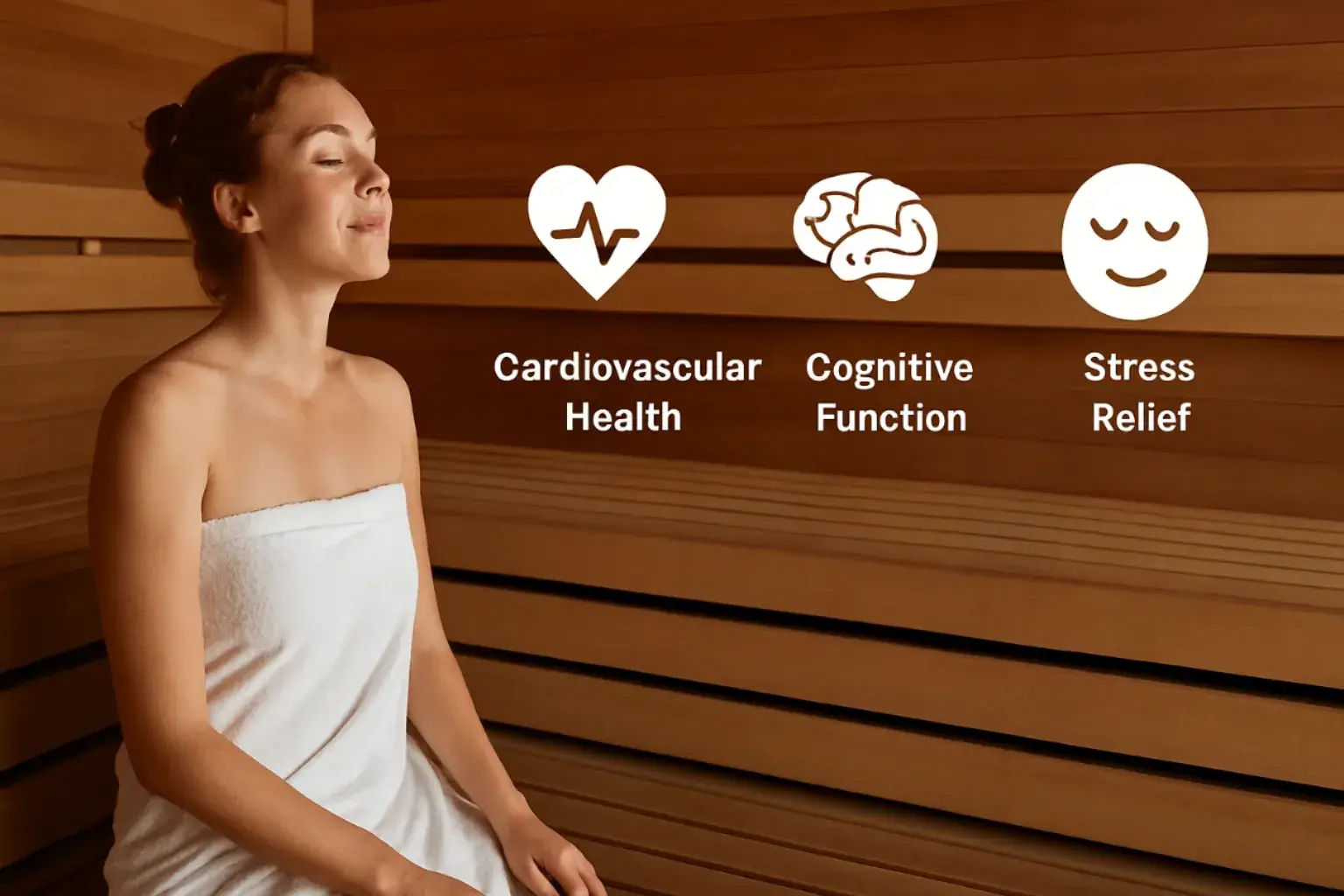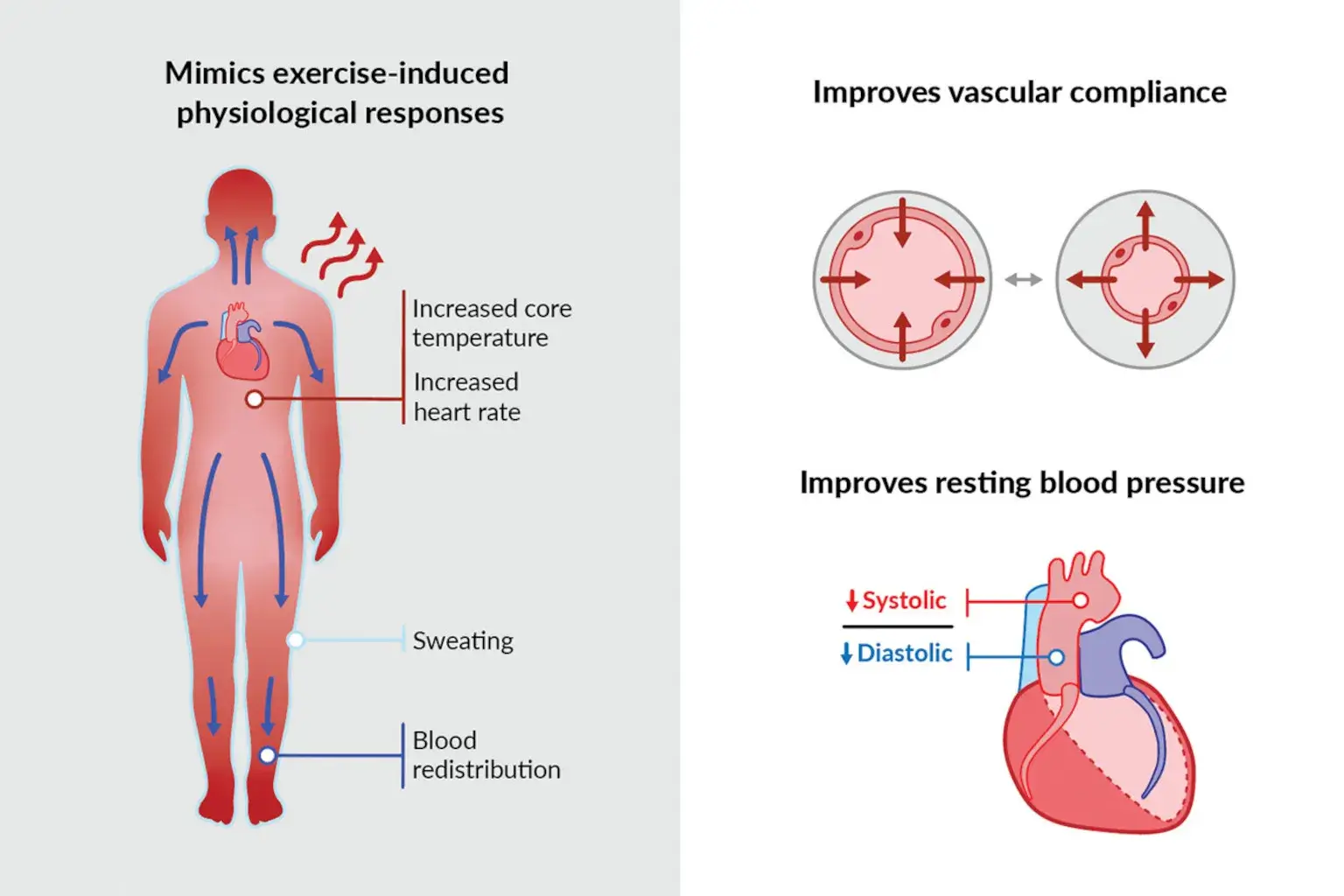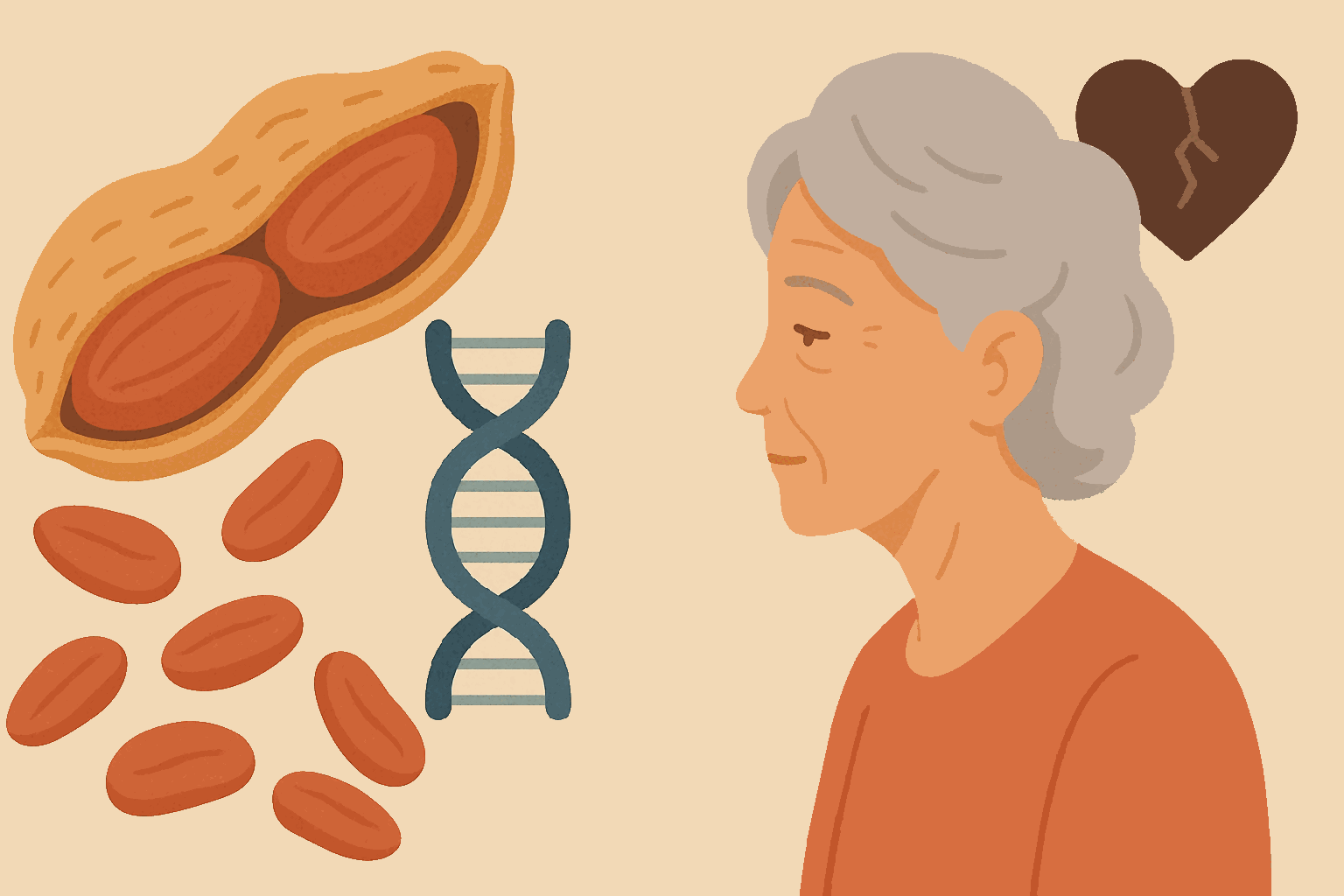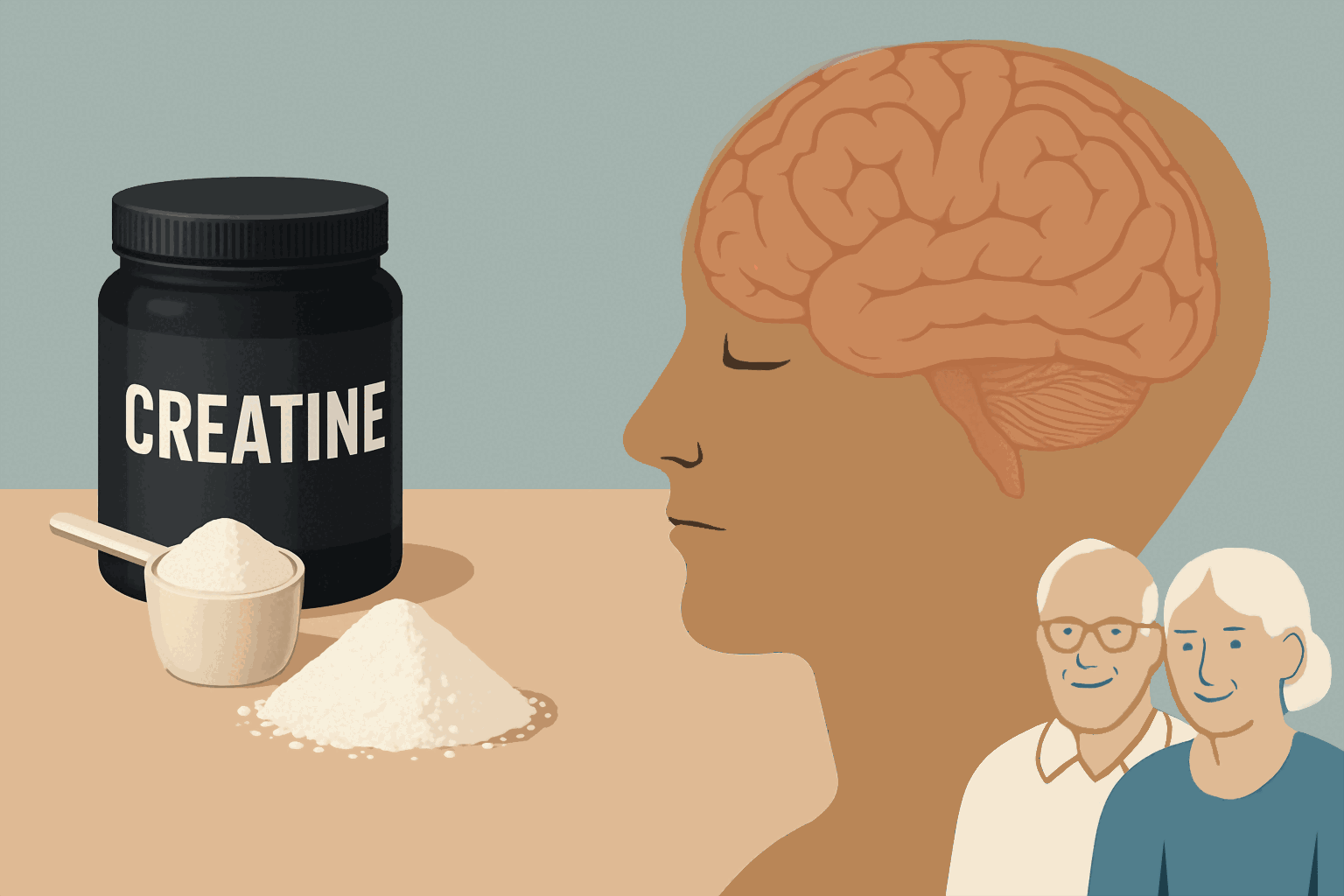
The Science-Backed Health Benefits of Regular Sauna Use
- Marcus Reed
- Health , Wellness , Science , Longevity
- May 20, 2025
Table of Contents
Fast Facts: Sauna Use & Your Health (TL;DR)
- Longevity Boost: Regular sauna use (4-7 times/week) linked to up to 40% lower all-cause mortality [1].
- Heart Healthy: Improves cardiovascular function, lowers blood pressure, and reduces arrhythmia risk [7].
- Brain Power: May decrease dementia risk by up to 65% and enhances mood via BDNF and dopamine.
- Cellular Resilience: Triggers Heat Shock Proteins (HSPs) to repair cells and reduce inflammation [2].
- Mimics Exercise: Provides cardiovascular conditioning similar to moderate-intensity workouts [5].
- Safe Use is Key: Follow protocols for temperature, duration, and hydration; consult a doctor if you have health conditions [9].
Biological Mechanisms Behind Sauna Benefits: How Heat Optimizes Health
For centuries, cultures worldwide have recognized the rejuvenating power of heat. Today, a robust body of scientific research substantiates these ancient practices, revealing that regular sauna use offers a wealth of physiological benefits. This BioBrain guide delves into the compelling clinical evidence behind sauna therapy, exploring its profound impact on longevity, heart health, cognitive function, and overall well-being. We’ll uncover how heat therapy works at a biological level and how you can safely integrate this powerful tool into your evidence-based wellness routine.
 Understanding how saunas benefit us starts at the cellular level. The body’s response to controlled heat stress is multifaceted and profoundly beneficial.
Understanding how saunas benefit us starts at the cellular level. The body’s response to controlled heat stress is multifaceted and profoundly beneficial.
1. Heat Shock Proteins (HSPs) Production: Your Cellular Repair Crew
Exposure to typical sauna temperatures (ranging from 60–90°C or 140-194°F) triggers a vital adaptive response in your cells: the production of Heat Shock Proteins (HSPs). These molecular chaperones are crucial for cellular housekeeping: they repair damaged proteins, bolster cellular defenses against stress (like oxidative stress), curb inflammation, and support robust immune function [2]. Clinical studies demonstrate that repeated sauna sessions can elevate HSP70 levels by a significant 49–76% in diverse populations [2], thereby enhancing cellular resilience crucial for healthy aging and protecting against various stressors.
2. Nitric Oxide-Driven Circulatory Benefits: Enhancing Blood Flow
Sauna sessions act as a potent stimulus for nitric oxide synthase activity, an enzyme that increases the bioavailability of nitric oxide (NOx) in your blood vessels. Studies have shown NOx concentrations can increase by 28–50% following heat exposure [4]. This master vasodilator is key to cardiovascular wellness: it typically lowers blood pressure by 5–20 mmHg, improves endothelial function (the health of your blood vessel linings), enhances microcirculation delivering vital nutrients to tissues, and reduces arterial stiffness, a hallmark of vascular aging [7].
3. Cardiovascular Conditioning Mimicry: A Workout for Your Heart
The heat stress from a sauna elicits cardiovascular responses similar to moderate physical activity. During a typical sauna session:
- Heart rate often increases to levels comparable to moderate-intensity exercise, typically 120–150 beats per minute (bpm).
- Cardiac output (the amount of blood your heart pumps per minute) can rise by 60–70%.
- Blood flow significantly redistributes, with up to 50–70% of cardiac output being directed to the skin to facilitate cooling.
These physiological responses strikingly mirror those seen during moderate-intensity aerobic exercise [5]. While not a substitute for physical activity, this makes regular sauna use an exceptionally valuable adjunctive therapy, especially for individuals who may have limitations engaging in conventional exercise programs.
4. Neurochemical Optimization: Boosting Brain Health and Mood
The brain also reaps significant rewards from heat exposure. Sauna use has been shown to:
- Stimulate a substantial increase in brain-derived neurotrophic factor (BDNF), potentially by 200–300%. BDNF is crucial for neuronal survival, growth, and the formation of new synapses.
- Elevate dopamine levels, a neurotransmitter associated with mood, motivation, and pleasure, by 20–30%.
- Activate the endogenous opioid system, releasing beta-endorphins which can induce feelings of euphoria and analgesia.
These neurochemical shifts collectively enhance mood, sharpen focus, promote neuroplasticity (the brain’s ability to adapt and learn), and can even reduce the perception of chronic pain, contributing to overall mental well-being [8].
Clinical Evidence: Mortality Reduction and Disease Prevention
The widespread biological effects of sauna bathing translate into tangible, long-term health outcomes demonstrated in clinical research.
All-Cause Mortality Reduction: Living Longer
A landmark 20-year Finnish cohort study, a cornerstone in sauna research, revealed a striking correlation between sauna frequency and longevity: individuals engaging in 2–3 weekly sessions experienced a 24% lower all-cause mortality risk, while those enjoying 4–7 weekly sessions saw this risk plummet by an astounding 40% [1]. This research, supported by reviews on healthspan [8], highlights the potential of regular sauna bathing as a powerful lifestyle factor for extending not just lifespan, but healthspan – the years lived in good health.
Cardiovascular Benefits: Protecting Your Heart
The cardiovascular advantages are significant and well-documented [6], [7]:
- Arrhythmia reduction: One study observed 62% fewer ventricular premature contractions in patients with chronic heart failure who underwent sauna therapy [3].
- Heart failure improvement: Patients with chronic heart failure have shown a 22% increase in their 6-minute walk distance after regular sauna sessions.
- Hypertension control: Existing studies also point to a notable 5–10 mmHg systolic blood pressure reduction in prehypertensive individuals, offering a natural approach to hypertension management.
Cognitive Protection: Sharpening Your Mind
Beyond mood, long-term sauna use is linked to substantial neuroprotective effects. Observational studies indicate that frequent users (4-7 times per week) may experience up to a 65% lower risk of developing dementia and Alzheimer’s disease, and a 30% reduced stroke incidence compared to infrequent users [7], [8]. These benefits are partly attributed to enhanced memory retention and cognitive flexibility through BDNF-mediated neurogenesis and improved cerebral circulation.
Safety Protocols and Best Practices for Optimal Sauna Use
 To harness the benefits of sauna safely and effectively, adhere to these evidence-based guidelines [9]:
To harness the benefits of sauna safely and effectively, adhere to these evidence-based guidelines [9]:
Recommended Protocol
- Frequency: Aim for 2–4 times per week. Beginners should start with 1 session per week and gradually increase as tolerated.
- Duration: Sessions of 15–20 minutes are typically effective. Listen to your body and exit if you feel uncomfortable.
- Temperature: A range of 70–85°C (158–185°F) is common for Finnish saunas. Adjust based on personal tolerance and the type of sauna.
- Hydration: Hydration is paramount. Aim to drink 1–2 liters of water, ideally with electrolytes, throughout the day, ensuring you’re well-hydrated before and after your session.
- Cooling: Allow for gradual cooling by re-entering room temperature environments. Avoid extreme temperature shocks immediately post-sauna unless you are adapted and it’s part of a specific, informed protocol (like contrast therapy).
- Listen to Your Body: This is the most important rule. If you feel dizzy, nauseous, or unwell, leave the sauna immediately.
Absolute Contraindications
Sauna use should be avoided in these situations:
- Acute myocardial infarction (heart attack within the last 2 weeks)
- Severe unstable angina (chest pain)
- Severe aortic stenosis
- Active infections or febrile illnesses
- Alcohol or drug intoxication (increases risk of hypotension, arrhythmia, and accidents)
Relative Precautions (Consult Your Physician)
Individuals with certain conditions should exercise caution and always consult their physician before starting sauna therapy:
- Pregnancy (especially the first trimester; risk of hyperthermia to the fetus)
- Orthostatic hypotension (a tendency to get dizzy when standing up)
- Certain cardiovascular conditions not listed under absolute contraindications
- Kidney disease
- Use of certain medications (e.g., diuretics, antihypertensives, antihistamines that can impair sweating)
Always consult your physician before starting sauna therapy if you have pre-existing health conditions or are taking medications, to ensure it’s appropriate for your specific situation.
Practical Integration Strategies: Making Sauna Part of Your Life
1. Athlete Recovery and Performance Enhancement
Elite and amateur athletes can leverage sauna for recovery and performance. The combination of sauna sessions with controlled cold water immersion (CWI) can further amplify HSP activation and effectively manage exercise-induced inflammation. Notably, post-exercise sauna use has been shown to improve VO2 max, a key indicator of aerobic fitness, by 5–10% over a three-month period.
2. Stress Management and Sleep Optimization
In our high-stress world, sauna offers a sanctuary for relaxation. Pair sauna use with mindfulness meditation or deep breathing exercises during or after your session for synergistic cortisol reduction and enhanced relaxation. Optimal timing for some individuals is in the evenings (e.g., 7–9 PM) as the subsequent body cooling can promote deeper, more restful sleep by supporting natural melatonin production rhythms.
3. Supporting Detoxification Pathways
While the body’s primary detoxification organs are the liver and kidneys, sweating induced by saunas can assist in the excretion of some waste products and heavy metals [6], [10]. To support your body during sauna use:
- Pre-session: Ensure adequate hydration. Some protocols suggest antioxidants like Vitamin C.
- Post-session: Continue to hydrate well. Some individuals choose to support antioxidant pathways with supplements like N-acetylcysteine (NAC) and Vitamin E, but always consult your healthcare provider before starting any new supplement regimen. Focus on replenishing fluids and electrolytes with options like coconut water or specialized electrolyte drinks.
4. Family Wellness (with Caution)

Introducing older children to saunas can be a family wellness activity, but with strict protocols:
- Age: Generally suitable for children aged 6 and above, with shorter durations and lower temperatures.
- Temperature: Lower end, around 60–65°C (140–149°F).
- Duration: Start with 5 minutes, not exceeding 10–15 minutes based on comfort.
- Supervision: An adult must be present at all times.
- Hydration: Ensure children are well-hydrated before and after.
Future Research Directions: The Expanding Potential of Heat Therapy
The therapeutic potential of sauna and hyperthermia continues to expand, with exciting research avenues including:
- Cancer adjuvant therapy: Exploring hyperthermia’s ability to sensitize cancer cells to radiation and chemotherapy.
- Autoimmune modulation: Investigating the role of HSPs in regulating T-cell function and potentially mitigating autoimmune responses.
- Neurodegenerative disease prevention: Further studies on how sauna might protect dopaminergic pathways and delay the onset of conditions like Parkinson’s disease.
These emerging applications underscore the broad therapeutic possibilities of controlled heat exposure, promising new frontiers in preventive and complementary medicine.
Conclusion: Embrace the Heat for a Healthier Life
Regular sauna use, when approached with an understanding of its mechanisms and safety protocols, stands out as a low-cost, high-impact wellness strategy for enhancing multiple facets of health [6], [7]. While it is not a panacea or a replacement for regular exercise, a balanced diet, or necessary medical treatments, integrating 2–4 weekly sauna sessions can significantly boost physiological resilience and contribute to a longer, healthier life. As with any health intervention, individual responses can vary. Listen to your body, stay informed, and consult with your healthcare provider to tailor sauna use for your optimal well-being and to achieve your specific health goals.
Pro Tip: Track physiological responses using wearable devices – observe trends for consistent improvements in metrics like heart rate variability (HRV) and resting heart rate over 4–6 weeks of regular sauna use. These can be valuable indicators of your body’s adaptation to heat stress and improved autonomic nervous system function.
Frequently Asked Questions (Q&A)
Q1: How often should I use a sauna to see health benefits?
Q2: What are the main cardiovascular benefits of using a sauna?
Q3: Can sauna use improve mental health and cognitive function?
Q4: Is sauna use safe for everyone?
Q5: What are Heat Shock Proteins (HSPs) and why are they important in sauna therapy?
Disclaimer
The information provided on BioBrain is intended for educational purposes only and is grounded in science, common sense, and evidence-based medicine. It is not a substitute for professional medical advice, diagnosis, or treatment. Always consult a qualified healthcare provider before making significant changes to your diet, exercise routine, or overall health plan.
References
- Laukkanen T, Khan H, Zaccardi F, Laukkanen JA (2015) "Association between sauna bathing and fatal cardiovascular and all-cause mortality events"
- Bujak M, Giemza-Mech B, Stanienda-Sikora K, et al (2023) "The effects of a single and a series of Finnish sauna sessions on the immune response and HSP-70 levels in trained and untrained men"
- Liu Y, Zhao H, Li H, et al (2004) "Effects of repeated sauna treatment on ventricular arrhythmias in patients with chronic heart failure"
- Masuda A, Nakazato M, Kihara T, Minagoe S, Tei C (2005) "The effects of Waon therapy on patients with chronic heart failure: results of a prospective multicenter study"
- Kox M, van Eijk LT, Zwaag J, et al (2014) "Voluntary activation of the sympathetic nervous system and attenuation of the innate immune response in humans"
- Hussain J, Cohen M (2018) "Clinical Effects of Regular Dry Sauna Bathing: A Systematic Review"
- Laukkanen JA, Laukkanen T, Kunutsor SK (2018) "Cardiovascular and Other Health Benefits of Sauna Bathing: A Review of the Evidence"
- Patrick RP, Johnson TL (2021) "Sauna use as a lifestyle practice to extend healthspan"
- Harvard Health Publishing (2020) "Sauna Health Benefits: Are saunas healthy or harmful?"
- Crinnion WJ (2011) "Sauna as a valuable clinical tool for cardiovascular, autoimmune, toxin-elimination, and stress-related illnesses"
Tags :
- Sauna
- Heat therapy
- Wellness protocol
- Health benefits
- Cardiovascular health
- Cognitive function
- Stress relief
- Longevity
- Nitric oxide
- Bdnf
- Heat shock proteins
- Vo2 max alternatives
- Hsp
- Dopamine boost
- Self care
- Evidence based wellness
- How often sauna
- Sauna safety


